An Optimal Enhanced Kalman Filter for a ZUPT-Aided Pedestrian Positioning Coupling Model
Abstract
:1. Introduction
2. Materials and Methods
2.1. System Modeling
2.1.1. Pedestrian Indoor Positioning System Model
2.1.2. Analysis of Pedestrian Kinematics
2.1.3. Inertial Sensor Error Model
2.1.4. Attitude Fusion Filter Algorithm
2.1.5. Zero Velocity Update Algorithm
2.2. The Optimal Enhanced Kalman Filter
2.2.1. Determining Outliers
2.2.2. Determining Filter Divergence Using a Covariance Matching Algorithm
3. Results
3.1. Experimental Device and Data Acquisition
3.2. Experimental Environment Settings
3.3. Analysis of Experiments
3.3.1. Analysis of Errors of Inertial Sensor
3.3.2. Experimental Analysis of Attitude Information
3.3.3. Experimental Analysis of Zero Velocity Update
3.3.4. Analysis of Different Positioning Systems
4. Conclusions
Author Contributions
Funding
Acknowledgments
Conflicts of Interest
References
- Pasku, V.; Angelis, A.D.; Moschitta, A.; Carbone, P.; Nilsson, J.O. A magnetic ranging aided dead-reckoning indoor positioning system for pedestrian applications. In Proceedings of the IEEE Instrumentation and Measurement Technology Conference, Taipei, Taiwan, 23–26 May 2016. [Google Scholar]
- Li, X.; Xu, Q. A reliable fusion positioning strategy for land vehicles in GPS-denied environments based on low-cost sensors. IEEE Trans. Ind. Electron. 2017, 64, 3205–3215. [Google Scholar] [CrossRef]
- Wang, X.; Wang, X.; Feng, D.; Fu, J.; Kang, Z. Research on matching and localization of characteristic unanimous infrared dim and small targets. J. Electron. Meas. Instrum. 2016, 30, 1405–1410. [Google Scholar]
- Sinelnikov, Y.; Sutin, A.; Salloum, H.; Sedunov, N.; Sedunov, A. Mice ultrasonic detection and localization in laboratory environment. J. Acoust. Soc. Am. 2015, 138, 1791. [Google Scholar] [CrossRef]
- Faragher, R.; Harle, R. Location fingerprinting with Bluetooth low energy beacons. IEEE J. Sel. Areas Commun. 2015, 33, 2418–2428. [Google Scholar] [CrossRef]
- Chen, X.; Zou, S. Improved Wi-Fi indoor positioning based on particle swarm optimization. IEEE Sens. J. 2017, 17, 7143–7148. [Google Scholar] [CrossRef]
- Alvarez, Y.; Heras, F.L. ZigBee-based sensor network for indoor location and tracking applications. IEEE Lat. Am. Trans. 2016, 14, 3208–3214. [Google Scholar] [CrossRef]
- Yang, P.; Wu, W. Efficient particle filter localization algorithm in dense passive RFID tag environment. IEEE Trans. Ind. Electron. 2014, 61, 5641–5651. [Google Scholar] [CrossRef]
- Muqaibel, A.; Alahmari, A.; Kousa, M.; Mesbah, A.; Landlosi, A. NOLS mitigation for UWB positioning. Int. J. Remote Sens. 2014, 35, 7959–7977. [Google Scholar]
- Liu, P.; Yang, P.; Wang, C.; Huang, K.; Tan, T. A semi-supervised method for surveillance-based visual location recognition. IEEE Trans. Cybern. 2017, 47, 3719–3732. [Google Scholar] [CrossRef] [PubMed]
- Lasla, N.; Younis, M.F.; Ouadjaout, A.; Badache, N. An effective area-based localization algorithm for wireless networks. IEEE Trans. Comput. 2015, 64, 2103–2118. [Google Scholar] [CrossRef]
- Wang, G.; So, M.C.; Li, Y. Robust convex approximation methods for TDOA-based localization under NLOS conditions. IEEE Trans. Signal Process. 2016, 64, 3281–3296. [Google Scholar] [CrossRef]
- Ren, M.; Pan, K.; Liu, Y.; Guo, H.; Zhang, X.; Wang, P. A novel pedestrian navigation algorithm for a foot-mounted inertial-sensor-based system. Sensors 2016, 16, 139. [Google Scholar] [CrossRef] [PubMed]
- Lin, M.; Chen, W.; Li, B.; You, Z.; Chen, Z. Fast field calibration of MIMU based on the Powell algorithm. Sensors 2014, 14, 16062–16081. [Google Scholar]
- Gouwanda, D.; Gopalai, A.A. A robust real-time gait event detection using wireless gyroscope and its application on normal and altered gaits. Med. Eng. Phys. 2015, 37, 219–225. [Google Scholar] [CrossRef] [PubMed]
- Ngoc-Huynh, H.; Huu, T.P.; Gu-Min, J. Step-detection and adaptive step-length estimation for pedestrian dead-reckoning at various walking velocitys using a smartphone. Sensors 2016, 16, 1423. [Google Scholar]
- Raknim, P.; Lan, K.C. Gait Monitoring for early neurological disorder detection using sensors in a smartphone: Validation and a case study of parkinsonism. Telemed. J. e-Health 2015, 22, 75–81. [Google Scholar] [CrossRef] [PubMed]
- Yu, L.; Zheng, J.; Wang, Y.; Song, Z.; Zhan, E. Adaptive method for real-time gait phase detection based on ground contact forces. Gait Posture 2015, 41, 269–275. [Google Scholar] [CrossRef] [PubMed]
- Mo, S.; Chow, D. Accuracy of three methods in gait event detection during overground running. Gait Posture 2017, 59, 93–98. [Google Scholar] [CrossRef] [PubMed]
- Yang, F.; Kim, J.; Munoz, J. Adaptive gait responses to awareness of an impending slip during treadmill walking. Gait Posture 2016, 50, 175–179. [Google Scholar] [CrossRef] [PubMed]
- Chia, B.N.; Ambrosini, E.; Pedrocchi, A.; Ferrigno, G.; Monticone, M.; Ferrante, S. A novel adaptive, real-time algorithm to detect gait events from wearable sensors. IEEE Trans. Neural Syst. Rehabil. Eng. 2015, 23, 413–422. [Google Scholar] [CrossRef] [PubMed]
- Liu, D.; Li, Z.; Wang, X.; Zhang, J. Moving target detection by nonlinear adaptive filtering on temporal profiles in infrared image sequences. Infrared Phys. Technol. 2015, 73, 41–48. [Google Scholar] [CrossRef]
- Vintervold, Y.S. Camera-Based Integrated Indoor Positioning. Remote Sens. Environ. 2013, 131, 119–139. [Google Scholar]
- Li, Z.; Chang, G.; Gao, J.; Wang, J.; Hernandez, A. GPS/UWB/MEMS-IMU tightly coupled navigation with improved robust Kalman filter. Adv. Space Res. 2016, 58, 2424–2434. [Google Scholar] [CrossRef]
- Yang, H.; Li, W.; Luo, C.; Zhang, J.; Si, Z. Integrated SINS/WSN positioning system for indoor mobile target using novel asynchronous data fusion method. J. Sens. 2017, 2017, 7879198. [Google Scholar] [CrossRef]
- Balzano, W.; Formisano, M.; Gaudino, L. WiFiNS: A smart method to improve positioning systems combining WiFi and INS techniques. In Proceedings of the International Conference on Intelligent Interactive Multimedia Systems and Services, Vilamoura, Portugal, 21–23 June 2017; Springer: Cham, Switzerland, 2017; pp. 220–231. [Google Scholar]
- Gopalagrawal, K.; Sadhani, S.; Ahuja, R.; Khandelwal, S.; Koul, S. Parking navigation and payment system using IR Sensors and RFID technology. Int. J. Comput. Appl. 2015, 111, 5–7. [Google Scholar] [CrossRef]
- Li, Y.; Zhuang, Y.; Lan, H.; Zhou, Q.; Niu, X.; El-Sheimy, N. A hybrid WiFi/Magnetic matching/PDR approach for indoor navigation with smartphone sensors. IEEE Commun. Lett. 2016, 20, 169–172. [Google Scholar] [CrossRef]
- Zhuang, Y.; Li, Y.; Qi, L.; Lan, H.; Yang, J.; El-Sheimy, N. A two-filter integration of MEMS sensors and WiFi fingerprinting for indoor positioning. IEEE Sens. J. 2016, 16, 5125–5126. [Google Scholar] [CrossRef]
- Lv, W.; Kang, Y.; Li, Z.; Zhao, Y. Fuzzy-logic based adaptive weighting filter for strap-down inertial navigation systems. J. Clin. Microbiol. 2015, 31, 1971–1974. [Google Scholar]
- Sun, J.; Xu, X.; Liu, Y.; Zhang, T.; Li, Y. FOG random drift signal denoising based on the improved AR model and modified Sage-Husa adaptive Kalman filter. Sensors 2016, 16, 1073. [Google Scholar] [CrossRef] [PubMed]
- Ge, Q.; Shao, T.; Chen, S.; Wen, C. Carrier tracking estimation analysis by using the extended strong tracking filtering. IEEE Trans. Ind. Electron. 2017, 64, 1415–1424. [Google Scholar] [CrossRef]
- Habib, W.; Sarwar, T.; Siddiqui, A.M.; Touqir, I. Wavelet denoising of multiframe optical coherence tomography data using similarity measures. IET Image Process. 2017, 11, 64–79. [Google Scholar] [CrossRef]
- Mei, Y. A data selection method for adaptive linear prediction. Electron. Meas. Technol. 2016, 39, 159–162. [Google Scholar]
- Gao, Z.; Fang, J.; Guo, W. Application of anti-outlier robust filtering in Micro-inertial integrated navigation. J. Transduct. Technol. 2012, 25, 859–863. [Google Scholar]
- Lee, A.; Bertotti, G.; Serpico, C.; Mayergoyz, I. Power spectral density of magnetization dynamics driven by a jump-noise process. IEEE Trans. Magn. 2017, 53, 1–5. [Google Scholar] [CrossRef]
- Gao, L.; Qi, L.; Chen, E.; Duan, L. Discriminative multiple canonical correlation analysis for information fusion. IEEE Trans. Image Process. 2017, 27, 1951–1965. [Google Scholar] [CrossRef]
- Bhardwaj, R.; Kumar, V.; Kumar, N. Allan variance the stability analysis algorithm for MEMS based inertial sensors stochastic error. In Proceedings of the International Conference and Workshop on Computing and Communication, Vancouver, BC, Canada, 15–17 October 2015; pp. 1–5. [Google Scholar]
- Allan, D.W.; Levine, J. A historical perspective on the development of the Allan variances and their strengths and weaknesses. IEEE Trans. Ultrason. Ferroelectr. Freq. Control 2016, 63, 513–519. [Google Scholar] [CrossRef] [PubMed]
- Percival, D.B. A wavelet perspective on the Allan variance. IEEE Trans. Ultrason. Ferroelectr. Freq. Control 2016, 63, 538–554. [Google Scholar] [CrossRef] [PubMed]
- Quinchia, A.G.; Falco, G.; Falletti, E.; Dovis, F.; Ferrer, C. A comparison between different error modeling of MEMS applied to GPS/INS integrated systems. Sensors 2013, 13, 9549–9588. [Google Scholar] [CrossRef] [PubMed]




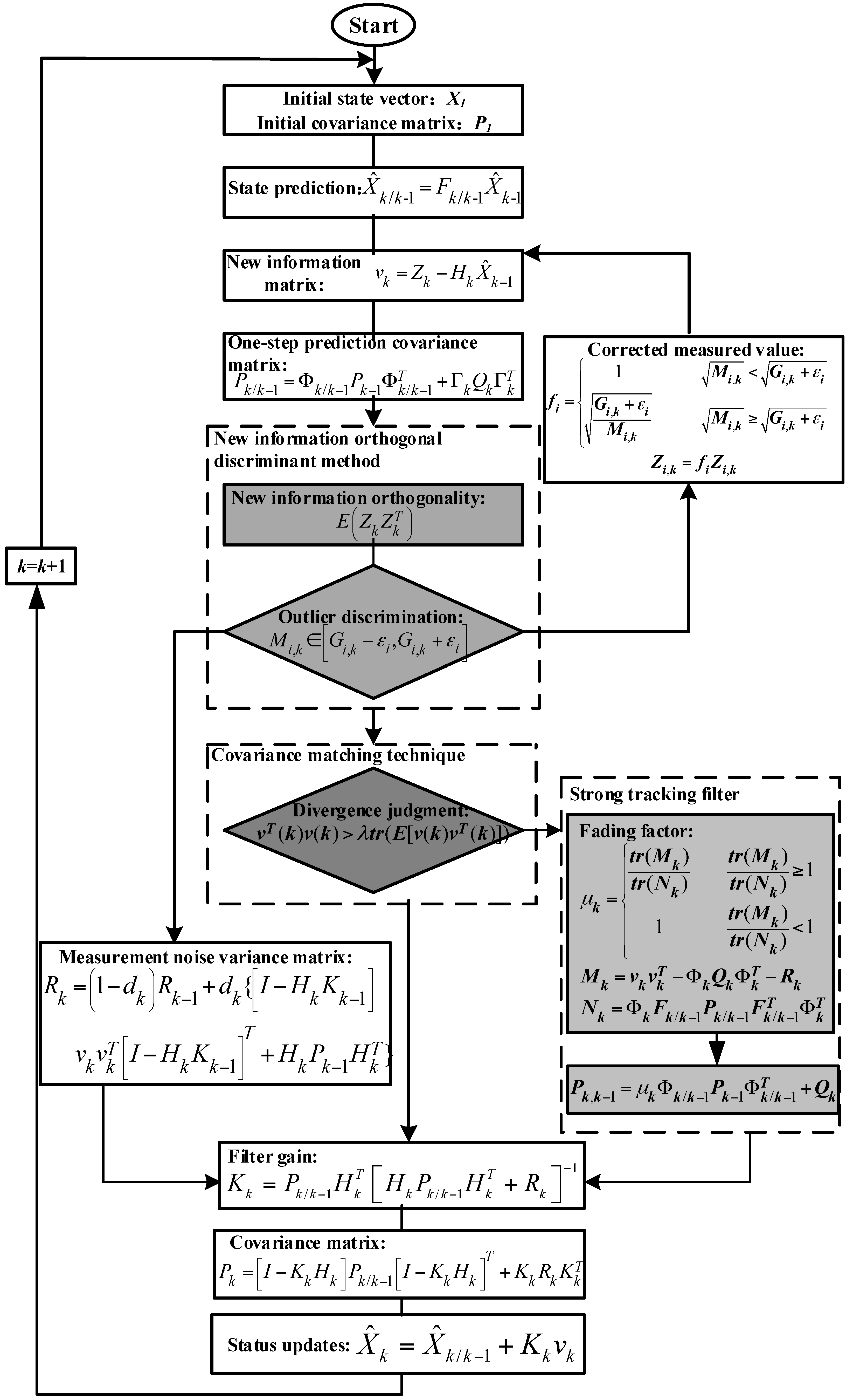
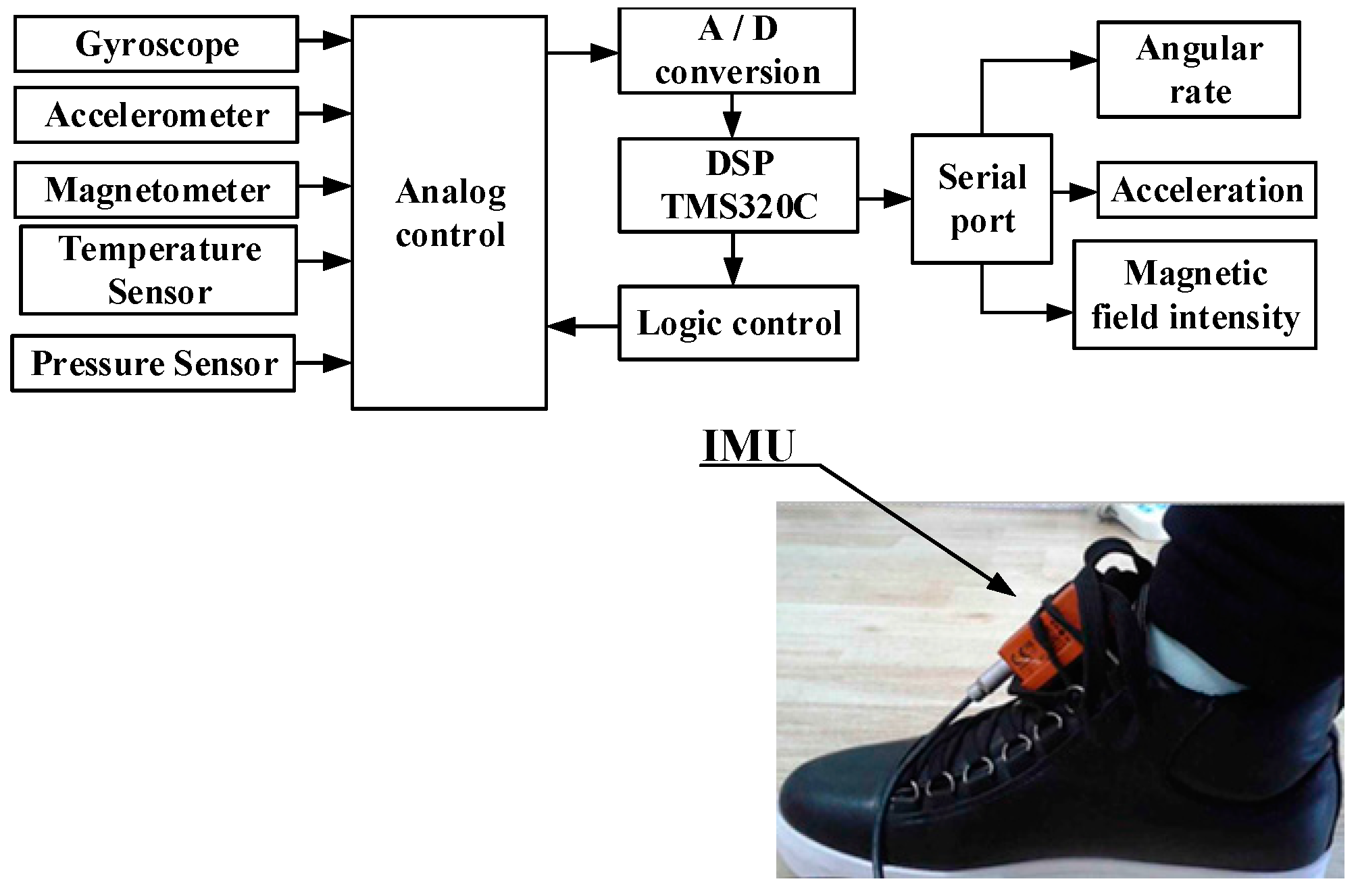
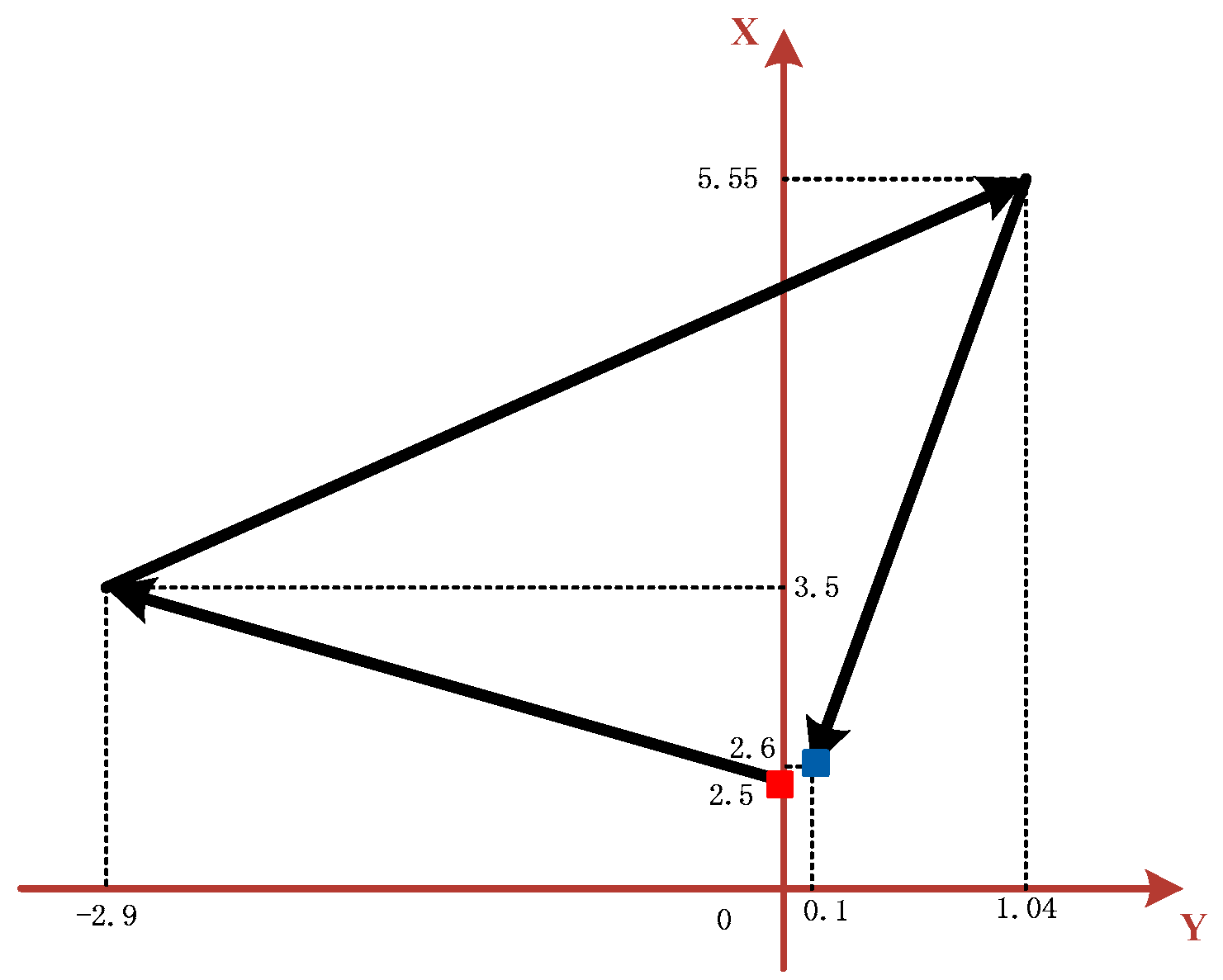
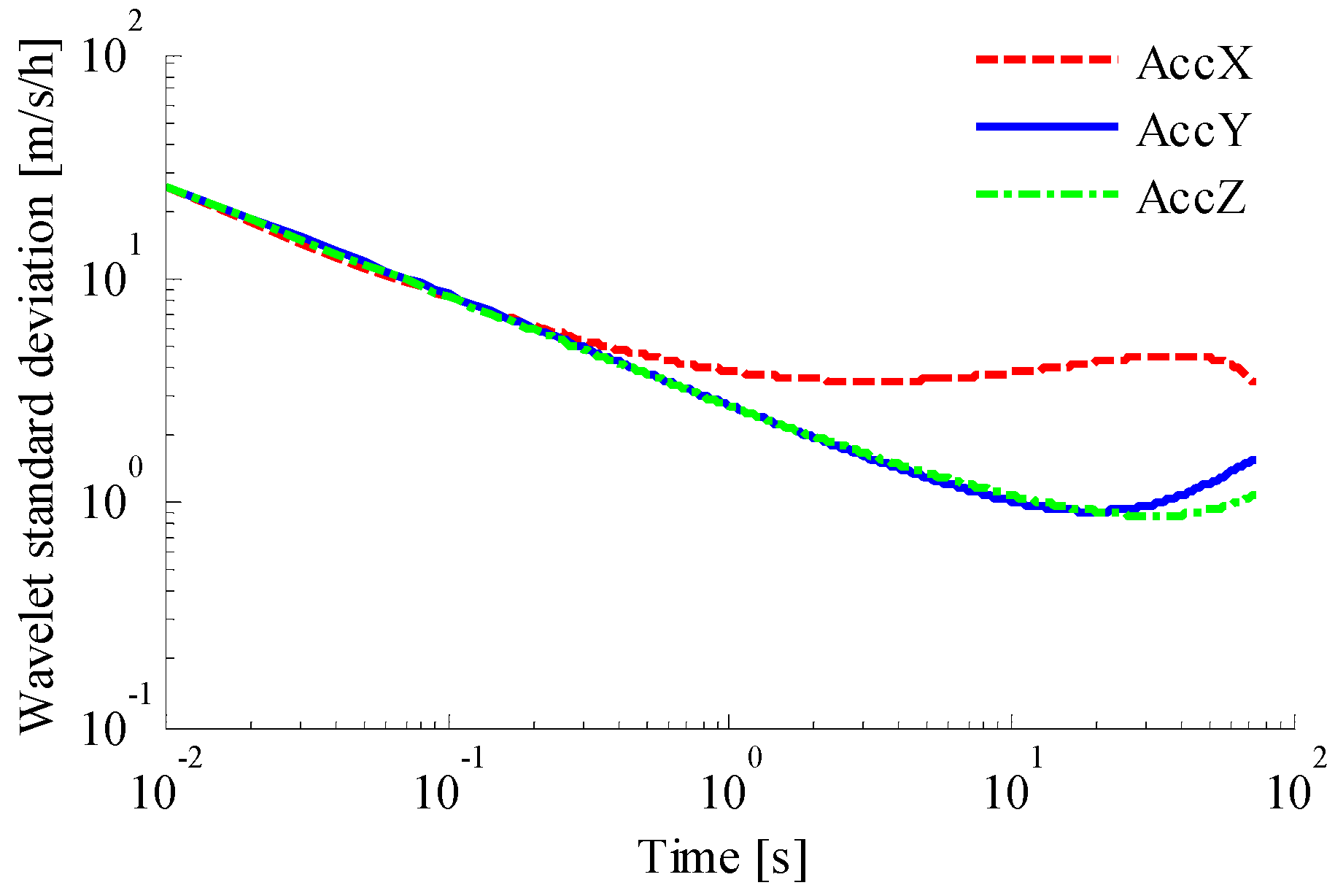
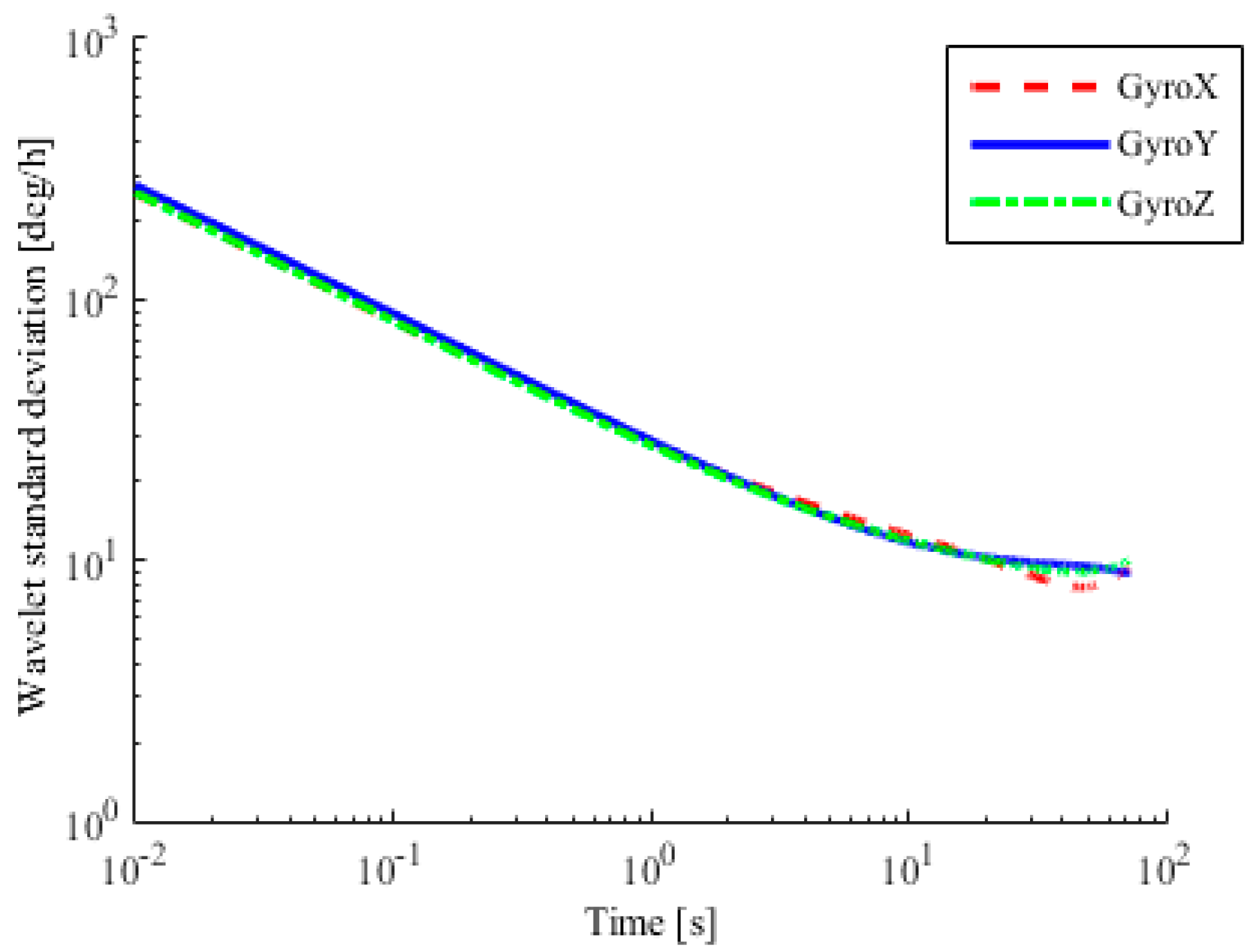

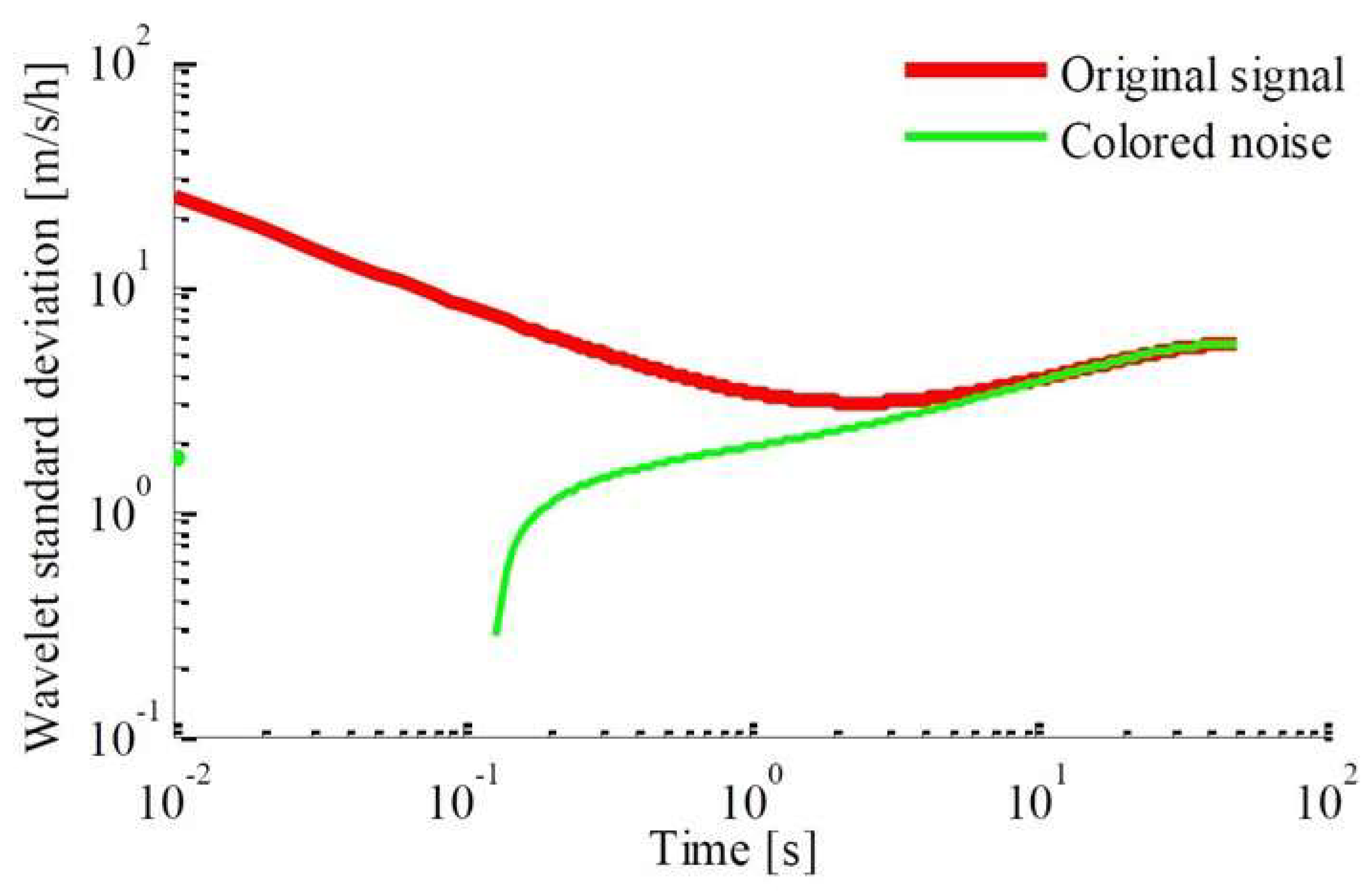

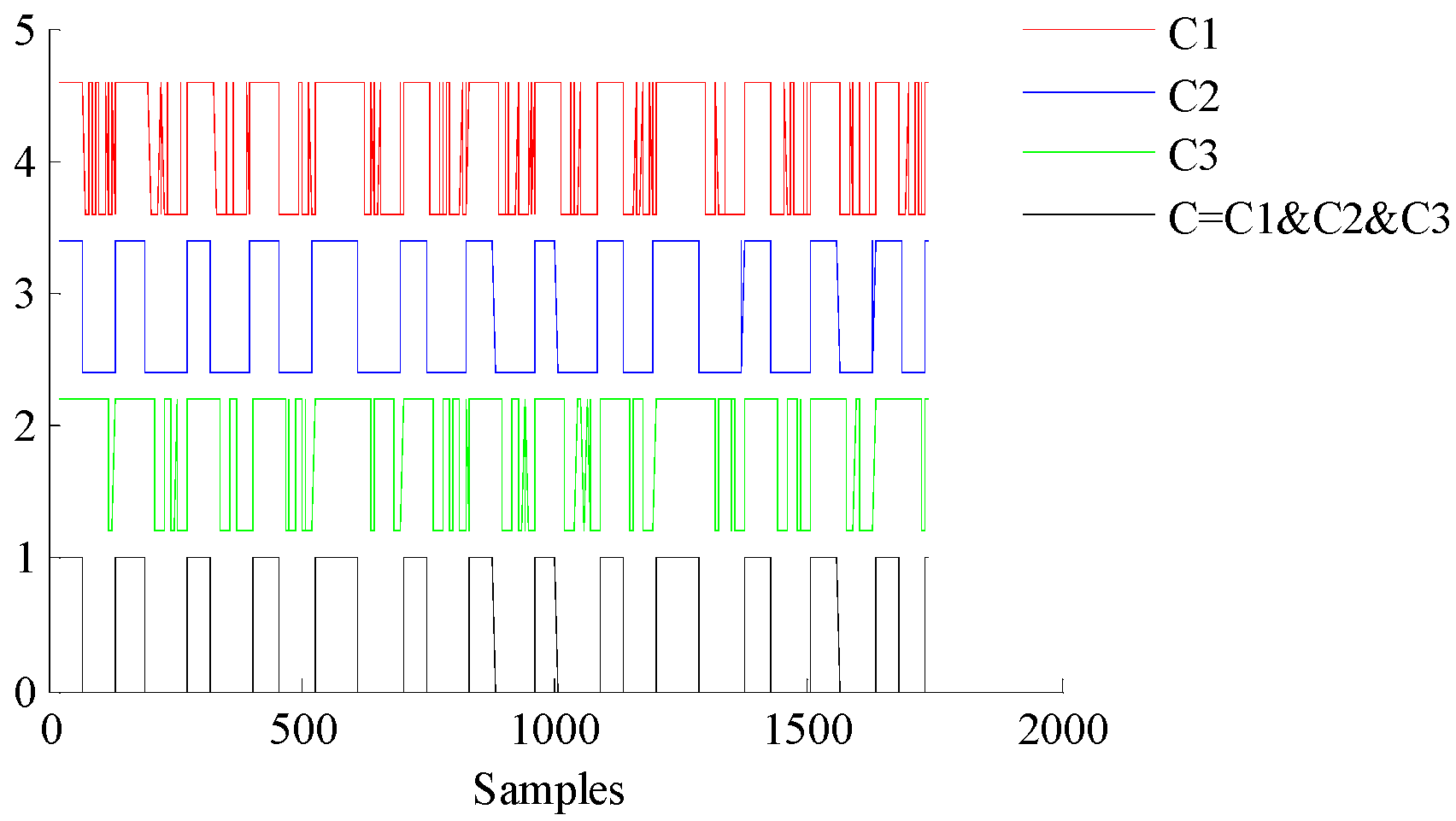
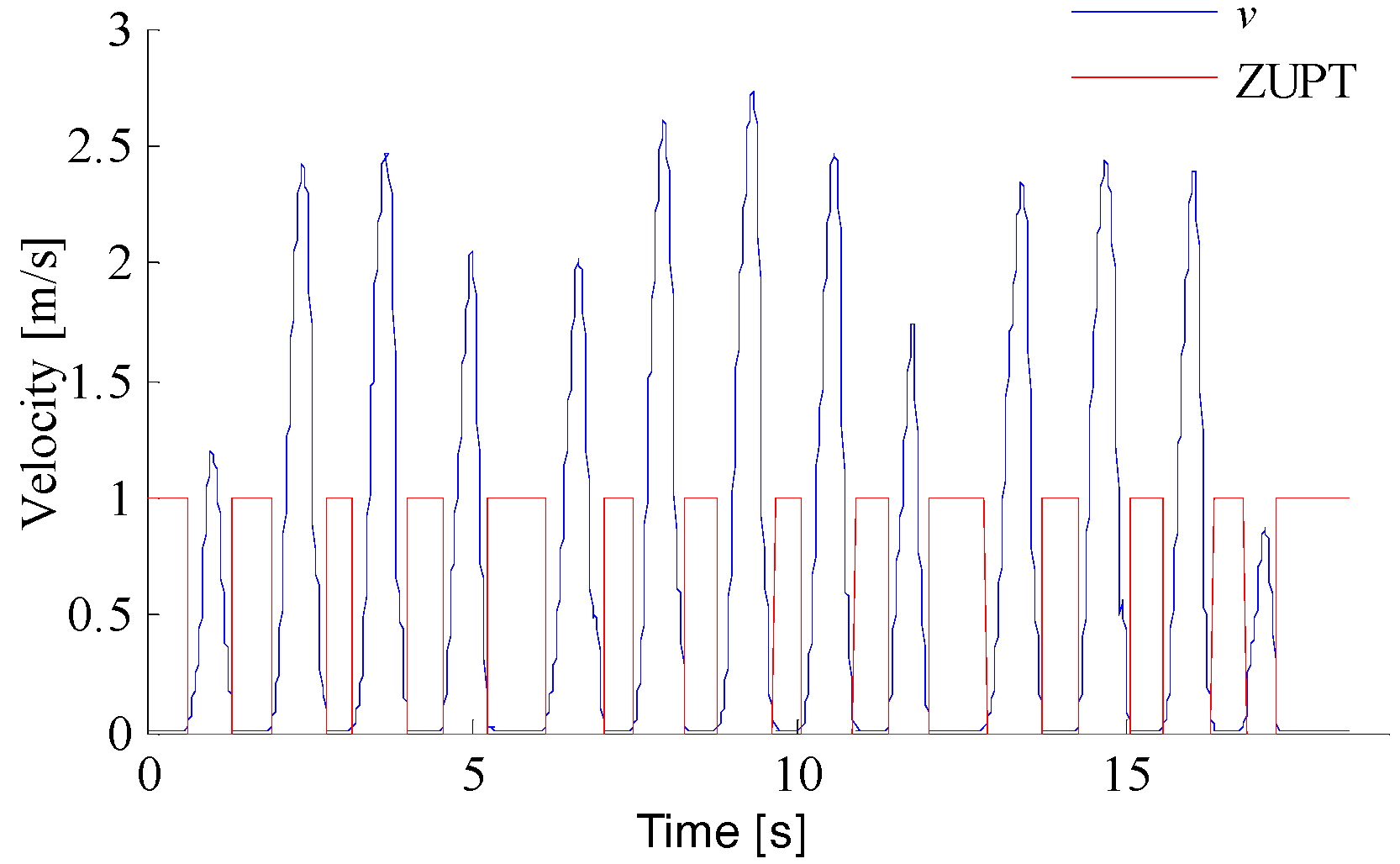

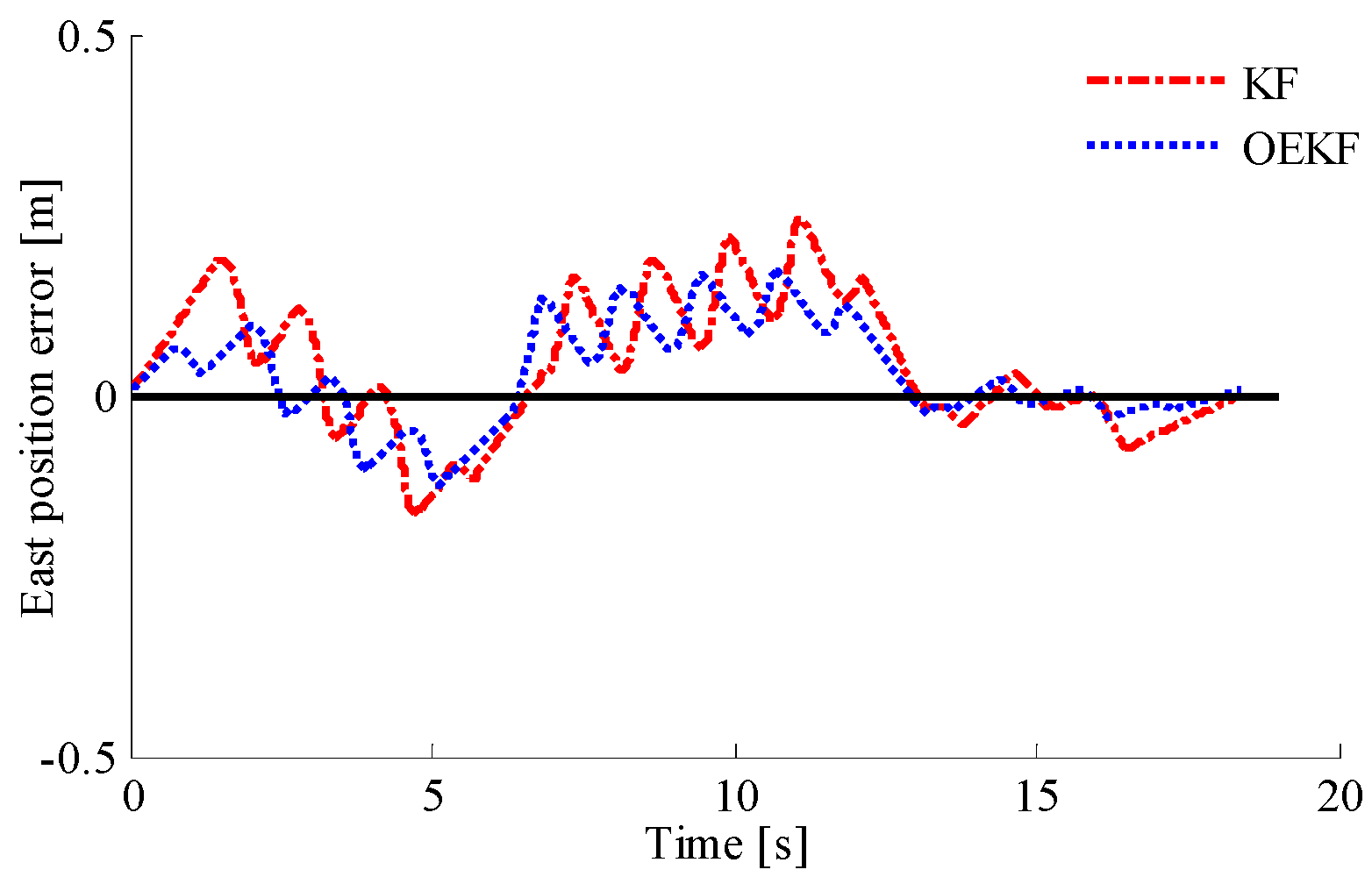

| Senor | Standard Full Range | Noise Density | Band Width | Voltage |
|---|---|---|---|---|
| Accelerometer | 50 m/s2 | 80 μg/√Hz | 375 Hz | 4.5 V |
| Gyroscope | 450°/s | 0.01°/s/√Hz | 450 Hz | 4.5 V |
| Magnetometer | ±80 μT | 200 μG/√Hz | N/A | 4.5 V |
| Error Item | AccX | AccY | AccZ |
|---|---|---|---|
| Acceleration random walk m/s/h3/2 | 80.953 | 7.8644 | 6.5712 |
| Instability of bias m/s/h | 4.3845 | 0.73242 | 1.0858 |
| Velocity random walk m/s/h1/2 | 0.040361 | 0.044576 | 0.043489 |
| Quantization noise m/s | 0.035239 | 0.040676 | 0.040221 |
| Error Item | GyroX | GyroY | GyroZ |
|---|---|---|---|
| Angle random walk °/h1/2 | 0.43234 | 0.46484 | 0.43525 |
| Instability of bias °/h | 16.296 | 10.872 | 13.737 |
| Quantization noise μrad | 1.2229 | 1.5065 | 1.3845 |
| KF | OEKF | |||
|---|---|---|---|---|
| East | North | East | North | |
| Range of error (m) | −0.1847 to 0.2455 | −0.1688 to 0.1222 | −0.1241to 0.1738 | −0.1251 to 0.0879 |
| Root mean square error (m) | 0.66 | 0.0816 | 0.0987 | 0.0360 |
| Residual rate (%) | 2.8560 | 2.8145 | 1.5251 | 1.5623 |
| Confidence (%) | 97.144 | 97.1855 | 98.4749 | 98.4377 |
© 2018 by the authors. Licensee MDPI, Basel, Switzerland. This article is an open access article distributed under the terms and conditions of the Creative Commons Attribution (CC BY) license (http://creativecommons.org/licenses/by/4.0/).
Share and Cite
Fan, Q.; Zhang, H.; Sun, Y.; Zhu, Y.; Zhuang, X.; Jia, J.; Zhang, P. An Optimal Enhanced Kalman Filter for a ZUPT-Aided Pedestrian Positioning Coupling Model. Sensors 2018, 18, 1404. https://doi.org/10.3390/s18051404
Fan Q, Zhang H, Sun Y, Zhu Y, Zhuang X, Jia J, Zhang P. An Optimal Enhanced Kalman Filter for a ZUPT-Aided Pedestrian Positioning Coupling Model. Sensors. 2018; 18(5):1404. https://doi.org/10.3390/s18051404
Chicago/Turabian StyleFan, Qigao, Hai Zhang, Yan Sun, Yixin Zhu, Xiangpeng Zhuang, Jie Jia, and Pengsong Zhang. 2018. "An Optimal Enhanced Kalman Filter for a ZUPT-Aided Pedestrian Positioning Coupling Model" Sensors 18, no. 5: 1404. https://doi.org/10.3390/s18051404
APA StyleFan, Q., Zhang, H., Sun, Y., Zhu, Y., Zhuang, X., Jia, J., & Zhang, P. (2018). An Optimal Enhanced Kalman Filter for a ZUPT-Aided Pedestrian Positioning Coupling Model. Sensors, 18(5), 1404. https://doi.org/10.3390/s18051404




